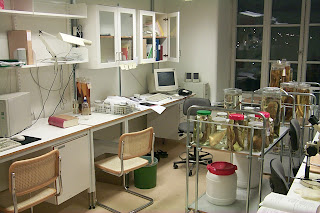It is true that most of the world’s population lives some distance away from a major natural history museum. Even if you live close and come often to visit the exhibits, what you experience is only a minor part of the activity, the objects and the spirits of a natural history “museum” (better called science collections or research collections). Only a fraction of the millions of objects are on display, and nearly all of the research and curation is out of sight.
Lack of public access to collections and research areas is sometimes lamented by the public, and in response to that some scientific collections do provide guided tours of the galleries for those with a special interest. With the right guide it can be exciting, but expect that for the non-specialist research collections tend to be highly repetitive, with large numbers of seemingly identical objects, and storage conditions are optimised for long-term storage and not for easy access for viewing. The researchers and collections staff are of course not on display. They have to work on, eternally understaffed, with their task to investigate and maintain the collections. Many scientific collections provide good insight into the research going on by public lectures and content-rich web sites. Projects like FishBase and GBIF make data and specimens from many collections available from their portals.
On occasion of the tricentennial of the birth of Petrus Artedi (1705-1735), Elizabeth Watson, Node Manager at GBIF-Sweden, made a film illustrating the change of scientific ichthyology from the lone man in the 18th Century taking notes by the lake to the industrial process including all sorts of technology and a rather large number of people that make Ichthyology at the Swedish Museum of Natural History, one of the major natural science collections in Europe.
One of the blessings of the Internet (in this case YouTube in particular) is that everyone with a reasonable bandwidth can now get behind the scenes in Ichthyology, in a shorter version of the Artedi film, illustrating the work of today.
